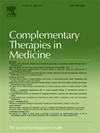远程瑜伽对 COVID-19 值班医护人员的职业倦怠、心理健康和免疫指标的影响:开放标签平行组试验随机对照试验。
IF 3.3
3区 医学
Q1 INTEGRATIVE & COMPLEMENTARY MEDICINE
引用次数: 0
摘要
背景:COVID-19 大流行使医疗保健系统不堪重负,并影响了医护人员的心理健康。事实证明,瑜伽可以改善包括医护人员在内的不同人群的心理健康相关性。考虑到大流行带来的限制,本试验旨在研究远程瑜伽干预对 COVID-19 值班医护人员的职业倦怠、睡眠质量、抑郁、焦虑、压力、正念和免疫指标的可行性和影响:这项随机对照试验在一家三级医院进行。每周五天进行远程瑜伽干预,为期 8 周。采用斯坦福职业满足感指数(SPFI)、匹兹堡睡眠质量指数(PSQI)、抑郁焦虑和压力量表(DASS-21)、正念注意力觉察量表(MAAS)来评估职业倦怠、睡眠质量、抑郁、焦虑、压力和正念。对血样进行了 TNF-α、IL-6 和血清皮质醇水平的评估:共筛选了 147 名医护人员,样本量为 90 人(远程瑜伽干预组和对照组各 45 人)。在干预组的 45 名受试者中,有 35 人在 8 周内至少参加了 50%的课程,每周参加 3.35 次。在 35 名受试者中,有近 37.14% 的人参加了 70% 以上的远程瑜伽课程。最后,干预组和对照组分别有 35 人和 37 人完成了结果问卷。在按方案分析(PPA)和意向治疗分析(ITT)中,远程瑜伽组的倦怠指数、PSQI、焦虑和压力评分以及 IL-6 和血清皮质醇水平均显著低于对照组(P结论:在 COVID-19 大流行期间,远程瑜伽对于改善三级医院医护人员的职业倦怠、睡眠质量,降低焦虑、压力、IL-6 和血清皮质醇水平是一种可行且易于接受的干预措施。由于这是一项在印度进行的单中心试点研究,且存在其他方法上的局限性,因此研究结果的推广性受到了限制:本临床试验已在印度临床试验注册中心进行了前瞻性注册[CTRI/2020/09/027842(注册日期:2020年9月16日)]。本文章由计算机程序翻译,如有差异,请以英文原文为准。
Effect of tele-yoga on burnout, mental health and immune markers of health care workers on COVID-19 duty: An open-label parallel group pilot randomized controlled trial
Background
The COVID-19 pandemic overburdened the healthcare system and affected the mental health of healthcare workers. Yoga has proven to improve mental health correlates, within diverse population groups, including healthcare workers. Considering the pandemic-imposed restrictions, this trial was designed to study the feasibility and effect of tele-yoga intervention on burnout, sleep quality, depression, anxiety, stress, mindfulness, and immune markers of healthcare workers on COVID-19 duty.
Methods
This randomized controlled trial was conducted in a tertiary care hospital. Tele-yoga intervention was delivered five days a week for 8 weeks. Stanford Professional Fulfilment Index (SPFI), Pittsburg Sleep Quality Index (PSQI), Depression Anxiety and Stress Scale (DASS-21), Mindfulness Attention Awareness Scale (MAAS) were used to assess the burnout, sleep quality, depression, anxiety, stress and mindfulness. Blood samples were assessed for TNF-α, IL-6 and serum cortisol levels.
Results
A total of 147 healthcare workers were screened to achieve a sample size of 90 (45 each in tele-yoga intervention and control group). Of the 45 subjects in the intervention group, 35 attended at least 50 % of sessions over 8 weeks, at the rate of 3.35 sessions per week. Nearly 37.14 % of subjects among 35 were able to attend more than 70 % of the tele-yoga sessions. At the endline, 35 in the intervention and 37 in the control group completed the outcome questionnaires. On both per protocol (PPA) and intention to treat analyses (ITT) the burnout index, PSQI, anxiety and stress scores and IL-6 and serum cortisol level were significantly lower among the tele-yoga group compared to control group participants (p<0.05) at the endline. The effect size was medium (r=0.3–0.5) favoring intervention group for most of the parameters.
Conclusions
Tele-yoga is a feasible and accessible intervention for improving burnout, sleep quality, and reducing anxiety, stress, IL-6, and serum cortisol among healthcare workers in tertiary care hospitals during the COVID-19 pandemic. Being a single-center pilot study in India and with other methodological limitations, the generalizability of the study findings is restricted.
求助全文
通过发布文献求助,成功后即可免费获取论文全文。
去求助
来源期刊

Complementary therapies in medicine
医学-全科医学与补充医学
CiteScore
8.60
自引率
2.80%
发文量
101
审稿时长
112 days
期刊介绍:
Complementary Therapies in Medicine is an international, peer-reviewed journal that has considerable appeal to anyone who seeks objective and critical information on complementary therapies or who wishes to deepen their understanding of these approaches. It will be of particular interest to healthcare practitioners including family practitioners, complementary therapists, nurses, and physiotherapists; to academics including social scientists and CAM researchers; to healthcare managers; and to patients. Complementary Therapies in Medicine aims to publish valid, relevant and rigorous research and serious discussion articles with the main purpose of improving healthcare.
 求助内容:
求助内容: 应助结果提醒方式:
应助结果提醒方式:


